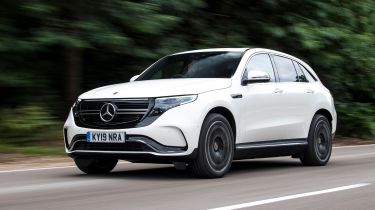Mercedes EQC (2019-2024) - Electric motor, performance and drive
Plenty of power and usable electric range add to the Mercedes EQC’s luxury SUV appeal.

Just so you know, this is an older review of the 2019-2024 Mercedes EQC. If you are interested in news about the latest Mercedes models, please follow the link provided.
When you first drive an electric car, the most obvious quality is the instant acceleration on offer – from a standing start and also while on the move. All of the EQC’s considerable 760Nm of torque is available from the moment you press the pedal, so it’s capable of shifting along at a decent pace – even given the SUV’s hefty 2.5 tonne weight.
Driver involvement is a different story, as there’s precious little on offer. Toggling through the driving modes puts the adaptive dampers to work and can firm up the ride, but the changes are minimal and aren’t enough to disguise the weight issue and the rather numb steering feel.
On balance, the EQC isn’t supposed to offer hot hatch levels of handling, and customers will no doubt see comfort and refinement as being much more important attributes. However, there is more driver involvement on offer from rivals, with the BMW iX in particular providing more feedback and a more sporting feel.
The EQC isn’t quite as adept at handling broken road surfaces at low speed as its Audi e-tron rival, although it performs better as you up the pace. It might well be an idea to steer clear of the biggest 21-inch wheels, as smaller wheels offer a better ride around town.
Engines
Mercedes’ first all-electric vehicle has an 80kWh battery powering two individual motors - one at each axle. The total power output is 403bhp which, along with the strong 760Nm of torque, enables the EQC to travel from 0-62mph in 5.1 seconds. Maximum speed is 112mph, which is about the current average for electric cars and helps to preserve battery charge and range.
During our own test of the EQC we managed the 0-62mph sprint in 5.2 seconds, but the more significant figures for real-world driving are the impressive 1.5 seconds it took to get from 30 to 50mph and 2.9 seconds from 50 to 70mph. In real world driving, it feels genuinely fast.









